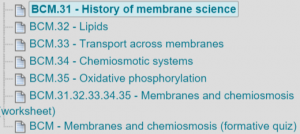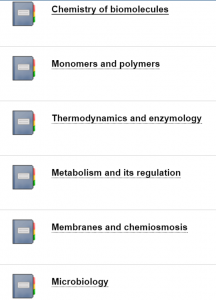 Congratulations if you have studied A-level Chemistry or any level in equivalence in high school! Cause the first two sections of BCM largely contain information about Chemistry. If you didn’t learn A-level Chemistry, that’s fine! (It’s not the end of the world!) The part of Chemistry involved in Biology is not that much. (Frankly you only need to know elements like C, O, H. N from the periodic table!)
Congratulations if you have studied A-level Chemistry or any level in equivalence in high school! Cause the first two sections of BCM largely contain information about Chemistry. If you didn’t learn A-level Chemistry, that’s fine! (It’s not the end of the world!) The part of Chemistry involved in Biology is not that much. (Frankly you only need to know elements like C, O, H. N from the periodic table!)
For the first section, Chemistry of biomolecules, instead of going through the PPT in lectures, pre-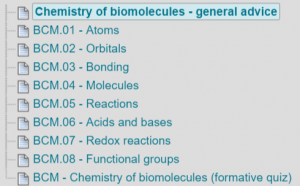 recorded lecture videos are provided to watch and learn in your own time. You will need to answer questions in lectures. (kind of like a problem-set class) Only those topics that are being questioned by many students will be taught straightforward in the lecture. Personally, I found the orbitals part quite intriguing and confusing as it involves lots of new theories from quantum physics and inorganic chemistry. Also if the majority of the lectures are taught by Dr. Steve Cook in the section, then that section usually contains a formative question set to test how well you have learnt those topics! (It’s quite useful :P) It contains 8 lectures (or 8 recordings to be more precise)
recorded lecture videos are provided to watch and learn in your own time. You will need to answer questions in lectures. (kind of like a problem-set class) Only those topics that are being questioned by many students will be taught straightforward in the lecture. Personally, I found the orbitals part quite intriguing and confusing as it involves lots of new theories from quantum physics and inorganic chemistry. Also if the majority of the lectures are taught by Dr. Steve Cook in the section, then that section usually contains a formative question set to test how well you have learnt those topics! (It’s quite useful :P) It contains 8 lectures (or 8 recordings to be more precise)
In the monomers and polymers section, you’ll find the things you learnt from A-level Biology quite 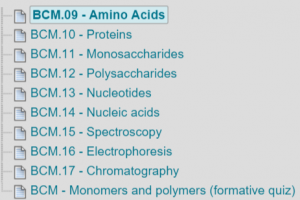 handy and there is extensive elaboration based on A-level. You will need to remember the structures of all amino acids (proteogenic) and their properties (hydrophobicity, polarity, sterioisomeric center, and so on). Now this can be a bit tricky to remember 😛 You’ll find that the spectroscopy, electropheresis, and chromatography quite different from what you have had in A-level during practicals. A great variety of each of these techniques are introduced and tested in the exams. External reading links are usually shown around the last pages of each lecture PPT. Be sure to check them out if you are interested in that topic. (It is also a good source for outside reading in essays) This sections contains 9 lectures.
handy and there is extensive elaboration based on A-level. You will need to remember the structures of all amino acids (proteogenic) and their properties (hydrophobicity, polarity, sterioisomeric center, and so on). Now this can be a bit tricky to remember 😛 You’ll find that the spectroscopy, electropheresis, and chromatography quite different from what you have had in A-level during practicals. A great variety of each of these techniques are introduced and tested in the exams. External reading links are usually shown around the last pages of each lecture PPT. Be sure to check them out if you are interested in that topic. (It is also a good source for outside reading in essays) This sections contains 9 lectures.
The first three lectures on thermodynamics and enzymology mostly contain information based on A-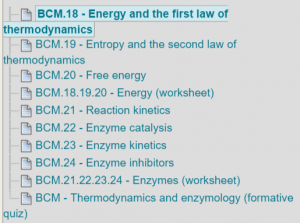 level chemistry and physics, it shouldn’t be a problem for you if you have had a concrete foundation of A-level knowledge. The remaining lectures are all about enzymes, its kinetics, its inhibitor mechanisms, its catalysis and so on. This is somehow an interesting topic but it might get a bit confusing at the lineweaver-burk plot where you have to work on few mathematical formulas and plots them in a graph. Many practice questions are included in this section and you should definitely work on them to improve your understanding of this topic 😛 This section contains 3 lectures in total.
level chemistry and physics, it shouldn’t be a problem for you if you have had a concrete foundation of A-level knowledge. The remaining lectures are all about enzymes, its kinetics, its inhibitor mechanisms, its catalysis and so on. This is somehow an interesting topic but it might get a bit confusing at the lineweaver-burk plot where you have to work on few mathematical formulas and plots them in a graph. Many practice questions are included in this section and you should definitely work on them to improve your understanding of this topic 😛 This section contains 3 lectures in total.
Here comes the hard core! In the metabolism and its regulation section, you will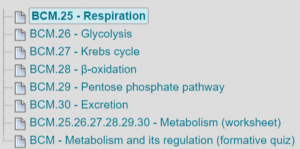 learn the first two thirds of the aerobic respiration metabolic pathways and various pathways around glycolysis and kreb’s cycle. (Including beta-oxidation where fatty acids are fed into kreb’s cycle, pentose phosphate pathway and excretion of things like nitrogenous compounds) Different enzymes catalysing different metabolites over different enzyme-catalytic reactions are related in a complex circle! (You will definitely get lost [I know I did] in the first place. Try to draw these pathways from time to time and say how much you can remember. Draw a huge one and stick it on your bedroom wall if you have to :P) This section contains 6 lectures (But loads of information here)
learn the first two thirds of the aerobic respiration metabolic pathways and various pathways around glycolysis and kreb’s cycle. (Including beta-oxidation where fatty acids are fed into kreb’s cycle, pentose phosphate pathway and excretion of things like nitrogenous compounds) Different enzymes catalysing different metabolites over different enzyme-catalytic reactions are related in a complex circle! (You will definitely get lost [I know I did] in the first place. Try to draw these pathways from time to time and say how much you can remember. Draw a huge one and stick it on your bedroom wall if you have to :P) This section contains 6 lectures (But loads of information here)
Eventually oxidative phosphorylation based on chemiosmotic system are talked about in the history of membrane science section. Various types of transport (new stuff like transporters and secondary active transport are introduced) across the membrane, development of membrane model, and its structure are included in this section. This sections contains 5 lectures.
Finally it’s Microbiology! 😛 Huw Williams is a really experienced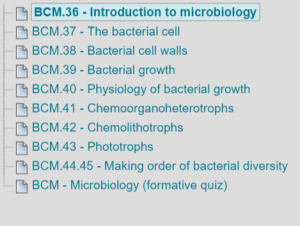 and kind lecturer, I hope you’d like him 😛 Ever wondered what chemoorganoheterotroph means? 😛 And extensive talks will be given on bacterial cell wall structures in Gram positive and negative bacteria and energy metabolisms in different types of bacteria (chemolithotroph, chemorganoheterotroph, phototroph, and so on. Frankly, based on this year’s exam and the mock papers given, the only thing that’s likely to appear on exam for the last two lectures would be… 16s rRNA sequencing for the bacterial evolutionary studies 😀 This section contains 10 lectures 😀
and kind lecturer, I hope you’d like him 😛 Ever wondered what chemoorganoheterotroph means? 😛 And extensive talks will be given on bacterial cell wall structures in Gram positive and negative bacteria and energy metabolisms in different types of bacteria (chemolithotroph, chemorganoheterotroph, phototroph, and so on. Frankly, based on this year’s exam and the mock papers given, the only thing that’s likely to appear on exam for the last two lectures would be… 16s rRNA sequencing for the bacterial evolutionary studies 😀 This section contains 10 lectures 😀
Moving on to external readings, the following books are highly recommended to facilitate your studies on BCM. They are:
General BCM information (VERY USEFUL BOOK) : Voet, D. & Voet, J. G. (2004) Biochemistry. 3rd edition. New York, John Wiley and Sons, Inc.
To facilitate if you have a poor chemistry background: Fisher, J. & Arnold, J. R. P. (2004) Chemistry for biologists. BIOS Instant Notes, 2nd edition. Abingdon, Taylor and Francis.
I imagine most of you have studied A-level Maths, if you didn’t (erhhhhhh), well this might help you (I haven’t tried this book myself personally cause A-level Maths contains everything you need for Bio maths (except the maths in statistics). : Aitken, M., Broadhurst, B. & Hladky, S. (2009) Mathematics for Biological Sciences. New York, Garland Science.
Alright, so I have finished summarizing (VERY BRIEFLY) what you will encounter during the first term. I sure hope this can help you to give you a general idea of what you might expect in a University-level Biology course. As always, leave a comment below to give me your questions and I’ll answer them in the future post.


